Page 266 of 434
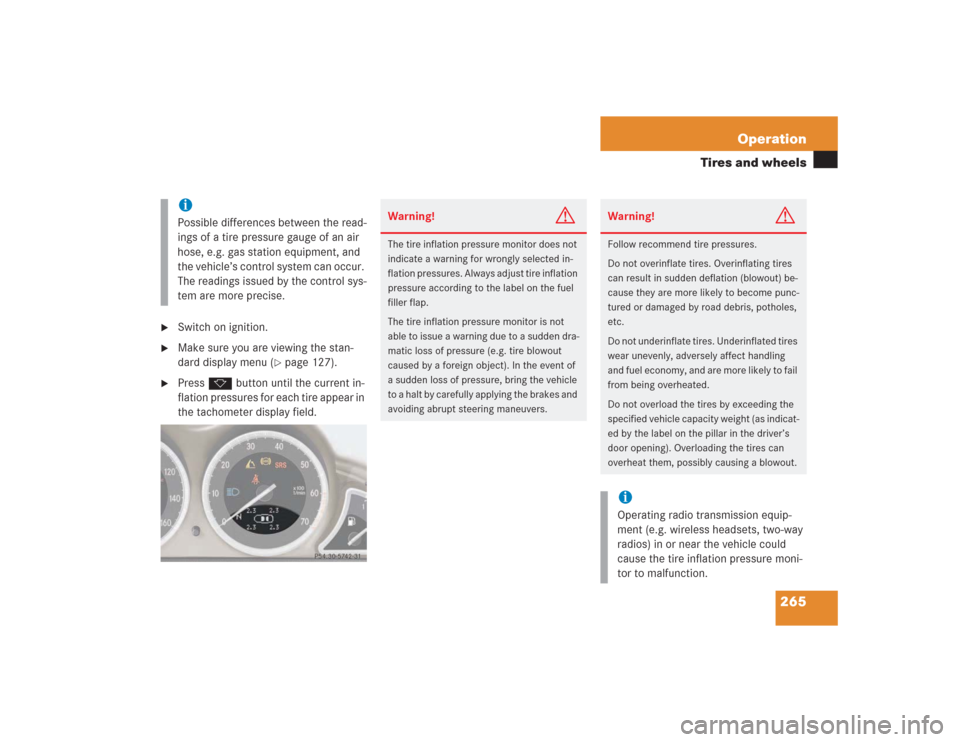
265 Operation
Tires and wheels
�
Switch on ignition.
�
Make sure you are viewing the stan-
dard display menu (
�page 127).
�
Press k button until the current in-
flation pressures for each tire appear in
the tachometer display field.iPossible differences between the read-
ings of a tire pressure gauge of an air
hose, e.g. gas station equipment, and
the vehicle’s control system can occur.
The readings issued by the control sys-
tem are more precise.
Warning!
G
The tire inflation pressure monitor does not
indicate a warning for wrongly selected in-
flation pressures. Always adjust tire inflation
pressure according to the label on the fuel
filler flap.
The tire inflation pressure monitor is not
able to issue a warning due to a sudden dra-
matic loss of pressure (e.g. tire blowout
caused by a foreign object). In the event of
a sudden loss of pressure, bring the vehicle
to a halt by carefully applying the brakes and
avoiding abrupt steering maneuvers.
Warning!
G
Follow recommend tire pressures.
Do not overinflate tires. Overinflating tires
can result in sudden deflation (blowout) be-
cause they are more likely to become punc-
tured or damaged by road debris, potholes,
etc.
Do not underinflate tires. Underinflated tires
wear unevenly, adversely affect handling
and fuel economy, and are more likely to fail
from being overheated.
Do not overload the tires by exceeding the
specified vehicle capacity weight (as indicat-
ed by the label on the pillar in the driver’s
door opening). Overloading the tires can
overheat them, possibly causing a blowout.iOperating radio transmission equip-
ment (e.g. wireless headsets, two-way
radios) in or near the vehicle could
cause the tire inflation pressure moni-
tor to malfunction.
Page 275 of 434
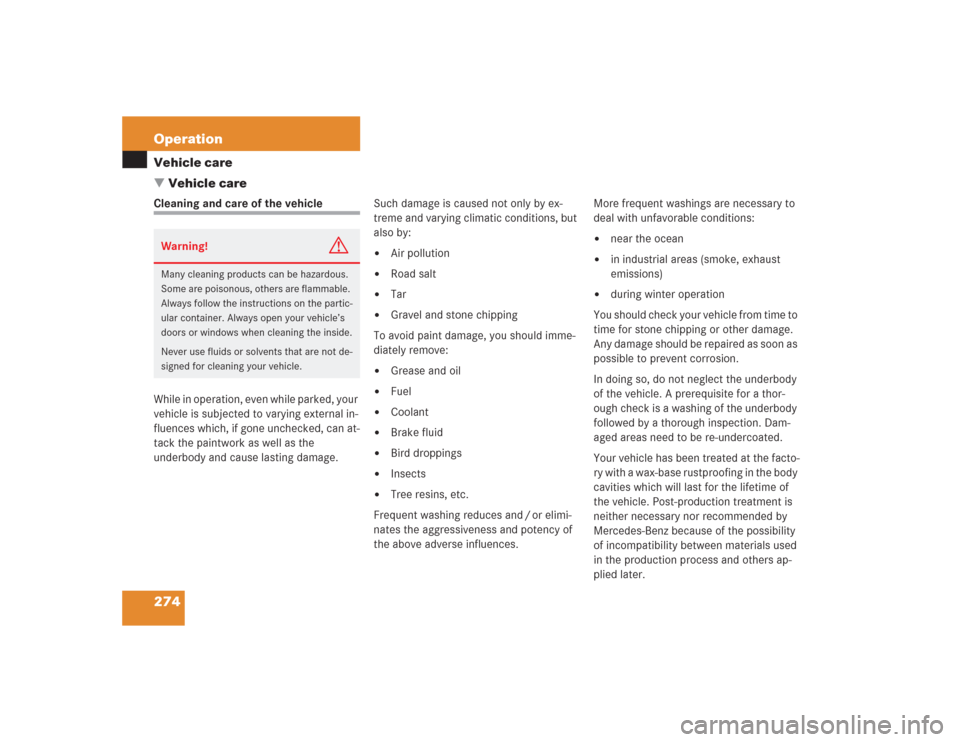
274 OperationVehicle care
�Vehicle careCleaning and care of the vehicle
While in operation, even while parked, your
vehicle is subjected to varying external in-
fluences which, if gone unchecked, can at-
tack the paintwork as well as the
underbody and cause lasting damage.Such damage is caused not only by ex-
treme and varying climatic conditions, but
also by:
�
Air pollution
�
Road salt
�
Tar
�
Gravel and stone chipping
To avoid paint damage, you should imme-
diately remove:
�
Grease and oil
�
Fuel
�
Coolant
�
Brake fluid
�
Bird droppings
�
Insects
�
Tree resins, etc.
Frequent washing reduces and / or elimi-
nates the aggressiveness and potency of
the above adverse influences.More frequent washings are necessary to
deal with unfavorable conditions:
�
near the ocean
�
in industrial areas (smoke, exhaust
emissions)
�
during winter operation
You should check your vehicle from time to
time for stone chipping or other damage.
Any damage should be repaired as soon as
possible to prevent corrosion.
In doing so, do not neglect the underbody
of the vehicle. A prerequisite for a thor-
ough check is a washing of the underbody
followed by a thorough inspection. Dam-
aged areas need to be re-undercoated.
Your vehicle has been treated at the facto-
ry with a wax-base rustproofing in the body
cavities which will last for the lifetime of
the vehicle. Post-production treatment is
neither necessary nor recommended by
Mercedes-Benz because of the possibility
of incompatibility between materials used
in the production process and others ap-
plied later.
Warning!
G
Many cleaning products can be hazardous.
Some are poisonous, others are flammable.
Always follow the instructions on the partic-
ular container. Always open your vehicle’s
doors or windows when cleaning the inside.
Never use fluids or solvents that are not de-
signed for cleaning your vehicle.
Page 286 of 434
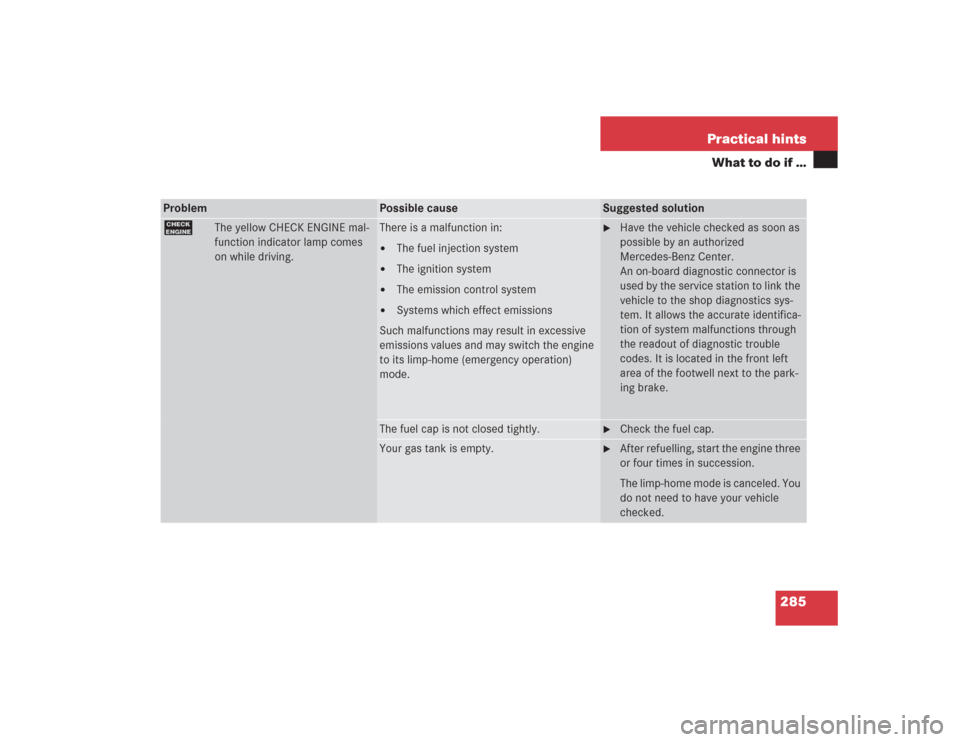
285 Practical hints
What to do if …
Problem
Possible cause
Suggested solution
?
The yellow CHECK ENGINE mal-
function indicator lamp comes
on while driving.
There is a malfunction in:�
The fuel injection system
�
The ignition system
�
The emission control system
�
Systems which effect emissions
Such malfunctions may result in excessive
emissions values and may switch the engine
to its limp-home (emergency operation)
mode.
�
Have the vehicle checked as soon as
possible by an authorized
Mercedes-Benz Center.
An on-board diagnostic connector is
used by the service station to link the
vehicle to the shop diagnostics sys-
tem. It allows the accurate identifica-
tion of system malfunctions through
the readout of diagnostic trouble
codes. It is located in the front left
area of the footwell next to the park-
ing brake.
The fuel cap is not closed tightly.
�
Check the fuel cap.
Your gas tank is empty.
�
After refuelling, start the engine three
or four times in succession.
The limp-home mode is canceled. You
do not need to have your vehicle
checked.
Page 288 of 434

287 Practical hints
What to do if …
Problem
Possible cause
Suggested solution
E
The red DTR indicator lamp
comes on while driving.
You are too close to the vehicle in front of you
to maintain selected speed.
�
Apply the brakes immediately to in-
crease the following distance.
E
The red DTR indicator lamp
comes on while driving and you
hear a warning sound.
�
You are gaining too rapidly on the vehicle
ahead of you.
�
The distance warning system has recog-
nized a stationary obstacle on your prob-
able line of travel.
�
Apply the brakes immediately.
�
Carefully observe the traffic situation.
You may need to brake or maneuver
to avoid hitting an obstacle.
E
The white DTR indicator lamp
comes on while driving.
The Distronic* distance sensor has recog-
nized a vehicle in front of you.
A
The yellow fuel tank reserve
warning lamp lights while driv-
ing.
The fuel level has dropped below the reserve
mark.
�
Refuel at the next gas station
(�page 250).
The fuel cap is not closed tight.
�
Check the fuel cap (
�page 250).
Page 304 of 434
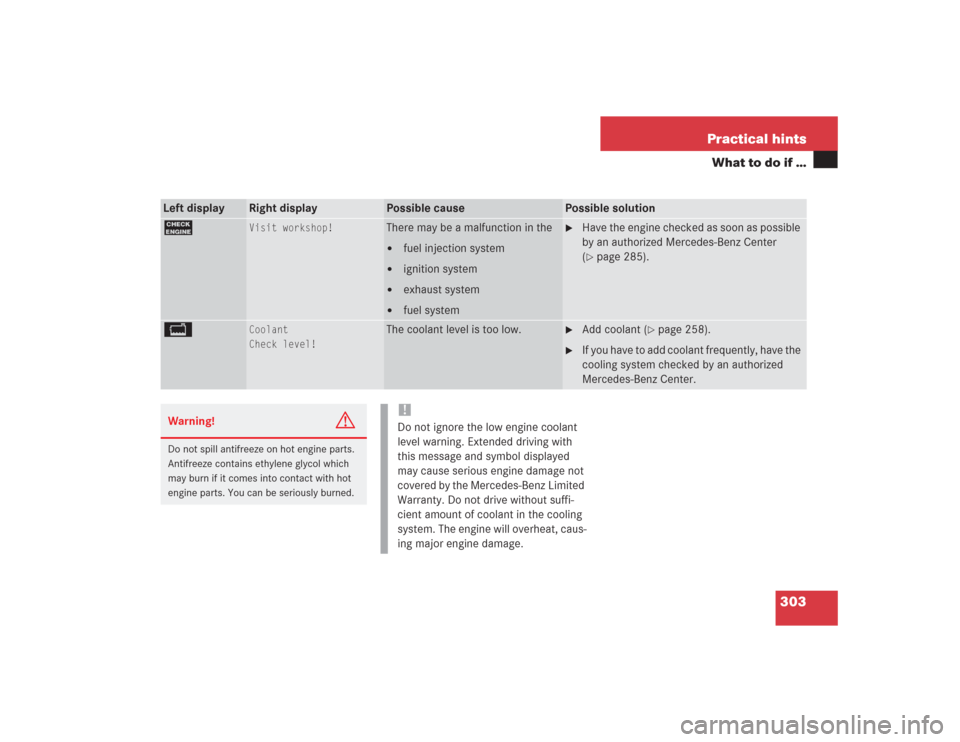
303 Practical hints
What to do if …
Left display
Right display
Possible cause
Possible solution
?
Visit workshop!
There may be a malfunction in the �
fuel injection system
�
ignition system
�
exhaust system
�
fuel system
�
Have the engine checked as soon as possible
by an authorized Mercedes-Benz Center
(�page 285).
B
Coolant
Check level!
The coolant level is too low.
�
Add coolant (
�page 258).
�
If you have to add coolant frequently, have the
cooling system checked by an authorized
Mercedes-Benz Center.
Warning!
G
Do not spill antifreeze on hot engine parts.
Antifreeze contains ethylene glycol which
may burn if it comes into contact with hot
engine parts. You can be seriously burned.
!Do not ignore the low engine coolant
level warning. Extended driving with
this message and symbol displayed
may cause serious engine damage not
covered by the Mercedes-Benz Limited
Warranty. Do not drive without suffi-
cient amount of coolant in the cooling
system. The engine will overheat, caus-
ing major engine damage.
Page 308 of 434
307 Practical hints
What to do if …
Left display
Right display
Possible cause
Suggested solution
:
USA only:Add 1 qt engine oil
at next refuelingCanada only:Add 1 l engine oil
at next refueling
The engine oil level is too low.
�
Add engine oil (
�page 257) and check the
engine oil level (�page 255).
Engine oil level
Stop, engine off!
There is no oil in the engine. There
is a danger of engine damage.
�
Carefully bring the vehicle to a halt as soon as
possible.
�
Turn off the engine.
�
Add engine oil (
�page 257) and check the
engine oil level (�page 255).
Engine oil level
Reduce oil level!
You have added too much engine
oil. There is a risk of damaging the
engine or the catalytic converter.
�
Have excess oil siphoned or drained off. Ob-
serve all legal requirements with respect to its
disposal.
Page 309 of 434
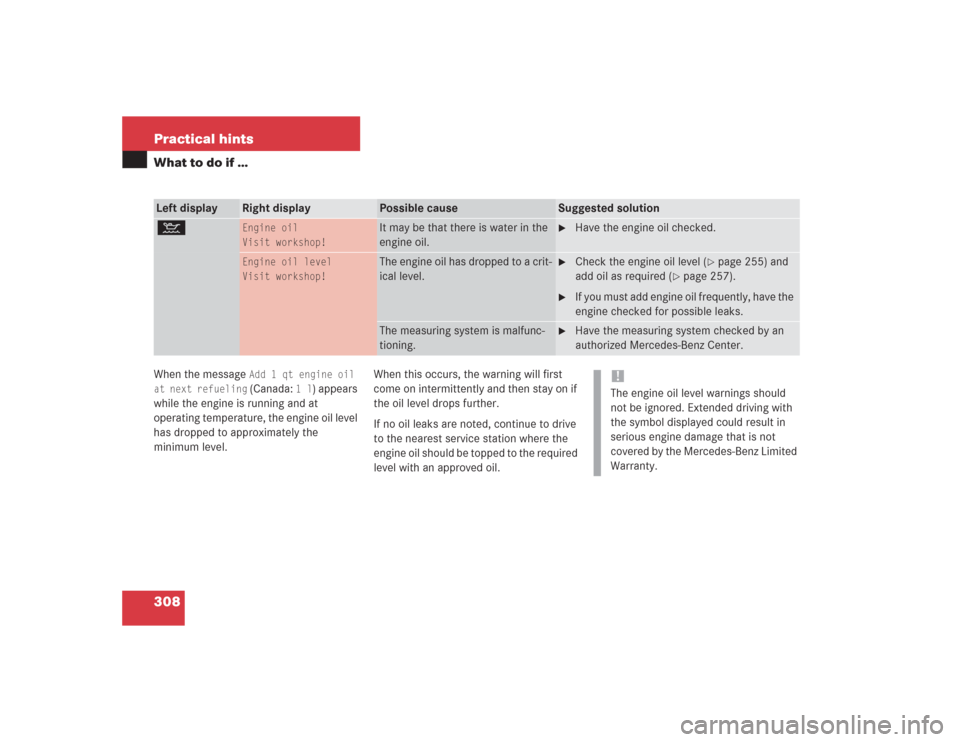
308 Practical hintsWhat to do if …When the message
Add 1 qt engine oil
at next refueling (Canada:
1l
) appears
while the engine is running and at
operating temperature, the engine oil level
has dropped to approximately the
minimum level.When this occurs, the warning will first
come on intermittently and then stay on if
the oil level drops further.
If no oil leaks are noted, continue to drive
to the nearest service station where the
engine oil should be topped to the required
level with an approved oil.
Left display
Right display
Possible cause
Suggested solution
:
Engine oil
Visit workshop!
It may be that there is water in the
engine oil.
�
Have the engine oil checked.
Engine oil level
Visit workshop!
The engine oil has dropped to a crit-
ical level.
�
Check the engine oil level (
�page 255) and
add oil as required (
�page 257).
�
If you must add engine oil frequently, have the
engine checked for possible leaks.
The measuring system is malfunc-
tioning.
�
Have the measuring system checked by an
authorized Mercedes-Benz Center.
!The engine oil level warnings should
not be ignored. Extended driving with
the symbol displayed could result in
serious engine damage that is not
covered by the Mercedes-Benz Limited
Warranty.
Page 310 of 434
309 Practical hints
What to do if …
Left display
Right display
Possible cause
Possible solution
A
Reserve fuel
The fuel level has dropped below
the reserve mark.
�
Refuel at the next gas station (
�page 250).
Check
gas cap!
See Oper’s Man.
The fuel cap is not closed tightly.
�
Check the fuel cap (
�page 250).
K
Visit
workshop!
The retractable hardtop is malfunc-
tioning.
�
Have the retractable hardtop checked by an
authorized Mercedes-Benz Center.
K
Lock
Vario-Roof
The retractable hardtop is not
locked properly.
�
Push or pull on the retractable hardtop switch
until the indicator lamp in the switch goes out
and the retractable hardtop is completely
open or closed (
�page 184).
O
Close hood!
You are driving with the hood open.
�
Close the hood (
�page 254).
I
Remove
key!
You have forgotten to remove the
SmartKey.
�
Remove the SmartKey from the starter
switch.
Replace
key!
The batteries in the SmartKey are
discharged.
�
Change the batteries (
�page 328).